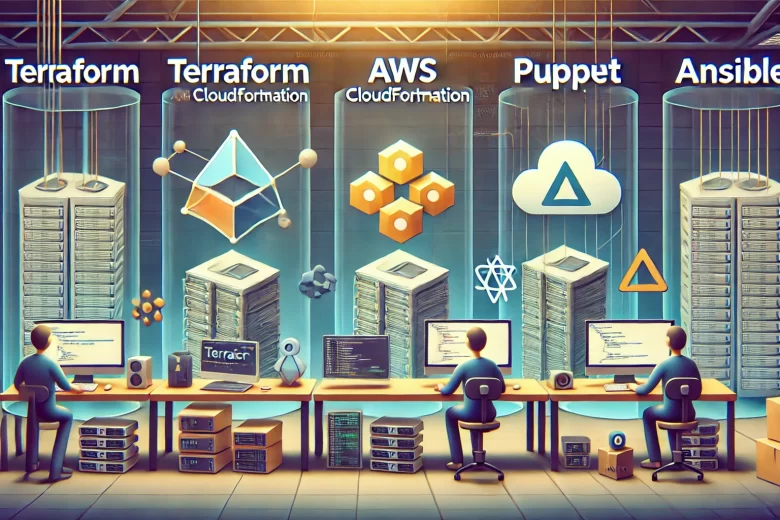In today’s cloud-driven world, managing infrastructure manually is both time-consuming and prone to errors. To solve this, engineers turn to Infrastructure as Code (IaC) tools, which automate the process of configuring and managing servers, networks, and other infrastructure components.
Four popular IaC tools stand out: Terraform, CloudFormation, Puppet, and Ansible. While they all aim to automate and simplify infrastructure management, they do so in different ways, with distinct features and use cases. Let’s explore how each of these tools works, and how they differ from each other.
Terraform
Terraform, developed by HashiCorp, is a platform-agnostic tool that allows users to define and provision infrastructure across multiple cloud providers using a high-level configuration language called HCL (HashiCorp Configuration Language). One of Terraform’s biggest strengths is its ability to work across multiple cloud environments like AWS, Azure, and Google Cloud, making it a great tool for multi-cloud strategies.
CloudFormation
CloudFormation is Amazon Web Services’ (AWS) native IaC tool. It allows users to define AWS infrastructure using JSON or YAML templates. CloudFormation is tightly integrated with AWS, making it a powerful tool for organizations that primarily use AWS services. However, it is limited to AWS infrastructure.
Puppet
Puppet is a configuration management tool that automates the provisioning, configuration, and management of systems. Unlike Terraform and CloudFormation, Puppet is agent-based and focuses on managing the state of infrastructure, ensuring systems remain in a defined state. It’s widely used in managing on-premises servers as well as cloud environments.
Ansible
Ansible is an open-source automation tool used for configuration management, application deployment, and task automation. It is agentless, meaning it doesn’t require software installation on managed systems. Ansible uses YAML for defining playbooks and is known for its simplicity and ease of use, making it popular for both cloud and on-premises environments.
Comparison Table: Terraform, CloudFormation, Puppet, and Ansible
| Feature | Terraform | CloudFormation | Puppet | Ansible |
|---|---|---|---|---|
| Primary Use | Infrastructure provisioning | AWS infrastructure provisioning | Configuration management | Configuration management and automation |
| Cloud Provider Support | Multi-cloud (AWS, Azure, GCP, etc.) | AWS-only | Multi-platform (cloud and on-premises) | Multi-platform (cloud and on-premises) |
| Language | HCL (HashiCorp Configuration Language) | JSON or YAML | Puppet DSL (Domain Specific Language) | YAML (Ansible Playbooks) |
| Agent Requirement | No | No | Yes (agent-based) | No (agentless) |
| State Management | Maintains state (tracks resources) | Maintains state | Ensures desired state | No built-in state tracking |
| Learning Curve | Moderate | Moderate to complex | Steeper (requires understanding of DSL) | Easy (simple syntax) |
| Multi-cloud Capability | Yes | No | Yes | Yes |
| Immutability | Infrastructure is treated as immutable | Immutable but AWS-focused | Focuses on configuring existing systems | Focuses on configuring existing systems |
| Orchestration | Limited | Limited | Strong for configuration | Strong for orchestration and automation |
| Community Support | Strong, large community | AWS-focused | Strong, long history | Strong, growing community |
| Vendor Lock-in | No (platform-agnostic) | Yes (AWS-specific) | No | No |
| Usage Type | Ideal for provisioning infrastructure | Ideal for AWS automation | Ideal for enforcing system state | Ideal for task automation and deployments |
Key Differences
- Cloud Provider Support:
- Terraform shines in multi-cloud environments, offering flexibility across different providers (AWS, Azure, GCP, etc.).
- CloudFormation is limited to AWS, making it less versatile but extremely powerful for AWS users.
- Puppet and Ansible both support multi-platform environments, including cloud and on-premises setups.
- Agent vs. Agentless:
- Puppet requires agents to be installed on each managed node, while Ansible, Terraform, and CloudFormation do not need agents.
- Ansible’s agentless nature simplifies the deployment process, especially in environments where installing agents is impractical.
- State Management:
- Terraform maintains a state file that tracks resource changes, allowing it to efficiently manage infrastructure.
- CloudFormation also tracks state within AWS, while Puppet ensures infrastructure is always in a desired state (declarative model). Ansible, on the other hand, doesn’t track state in the same way, meaning it is more focused on executing tasks.
- Immutability vs. Configuration:
- Terraform and CloudFormation treat infrastructure as immutable, meaning if changes are needed, resources are replaced or re-created.
- Puppet and Ansible focus on the continuous configuration of existing resources, ensuring they are kept in the desired state.
- Ease of Use:
- Ansible is known for its simple syntax and low learning curve, making it ideal for those new to IaC or configuration management.
- Terraform has a moderate learning curve but offers excellent flexibility for managing infrastructure across different platforms.
- Puppet is powerful but has a steeper learning curve due to its specialized DSL.
- CloudFormation can be complex due to the intricate nature of AWS services and the need to understand JSON or YAML.
Final Thoughts
Each of these tools has its strengths and is suited to different use cases. Terraform is ideal for multi-cloud infrastructure provisioning, while CloudFormation is a go-to for AWS-centric environments. Puppet excels in ensuring configuration consistency across large, complex environments, and Ansible offers flexibility with simple, agentless configuration management and automation.
Choosing the right tool depends on your specific needs – whether you’re managing a multi-cloud environment, configuring systems, or looking for deep integration with AWS. Understanding their differences will help you make the best decision for your infrastructure automation journey.

